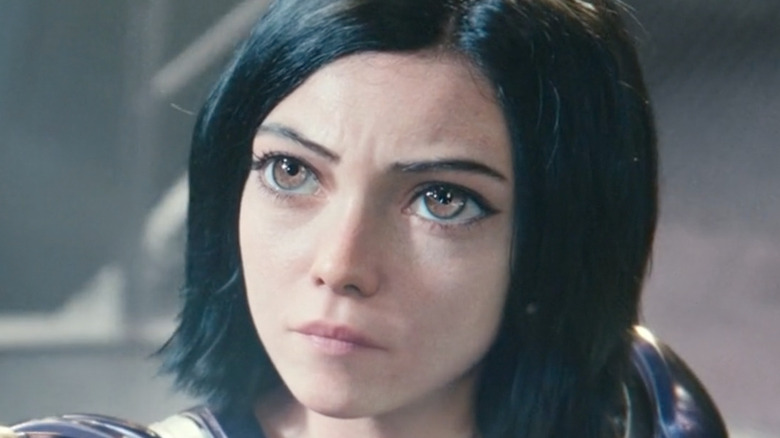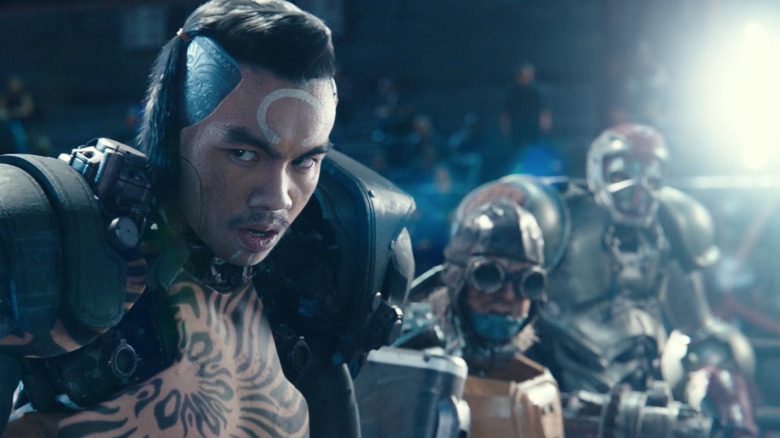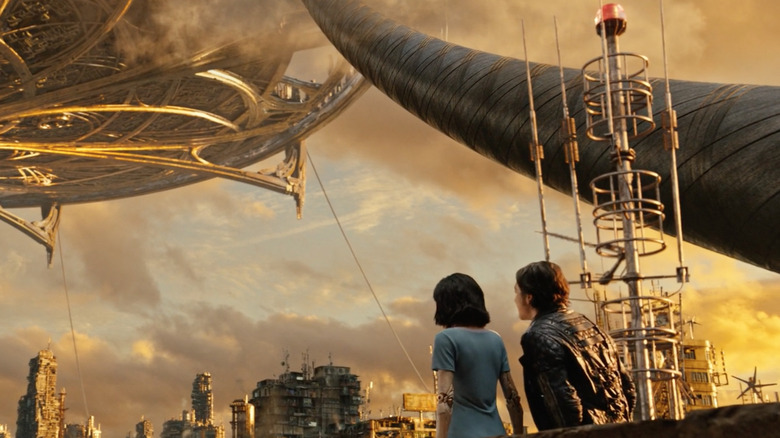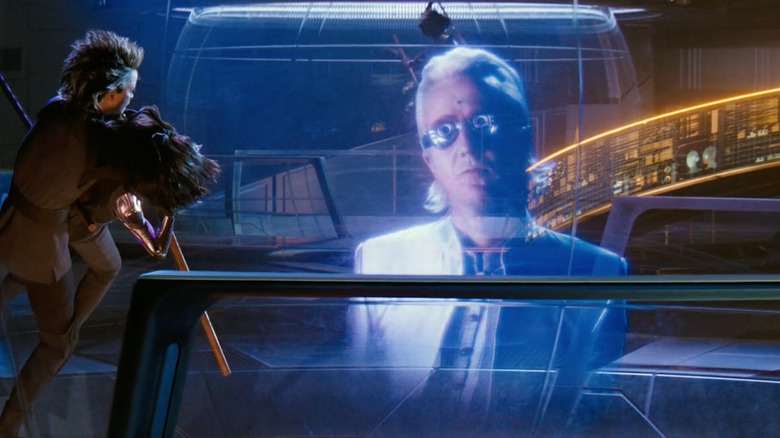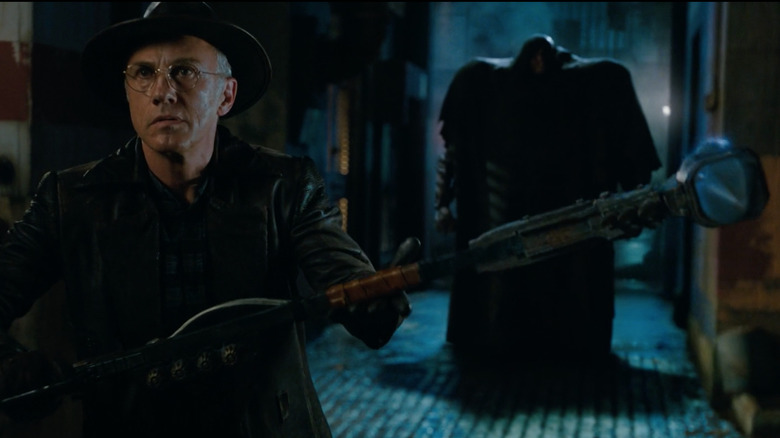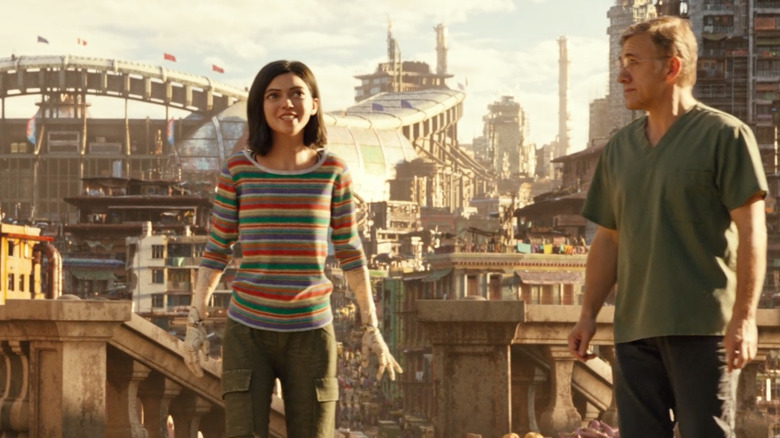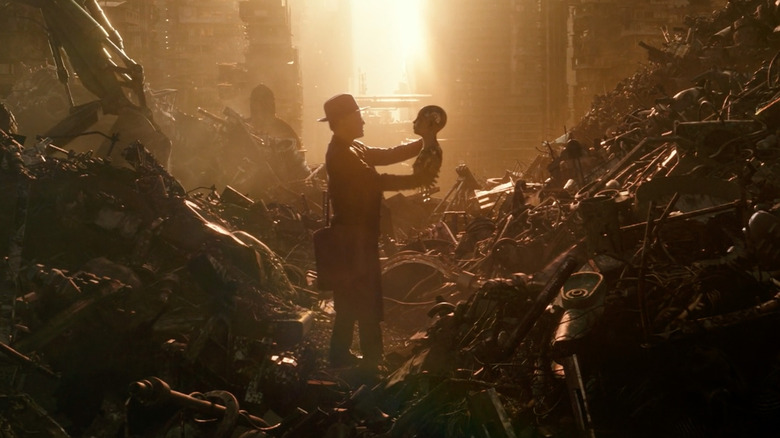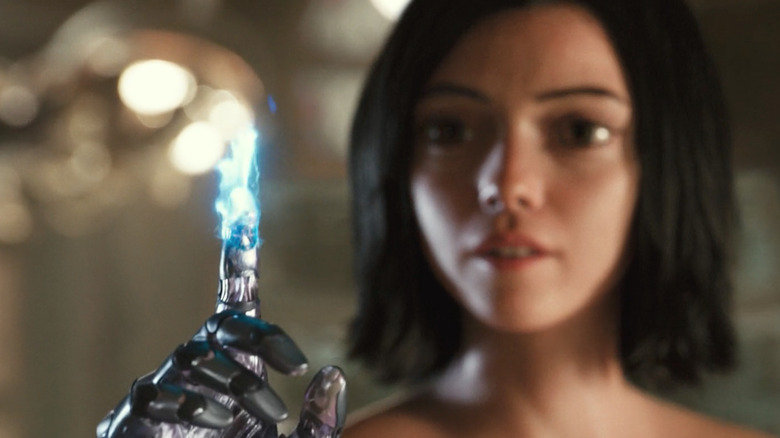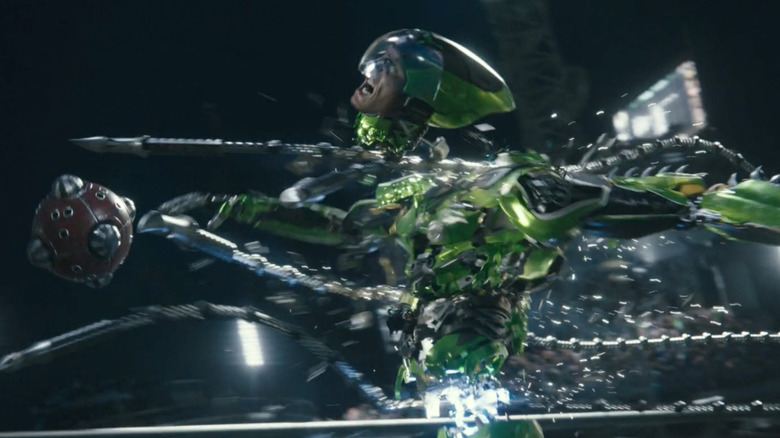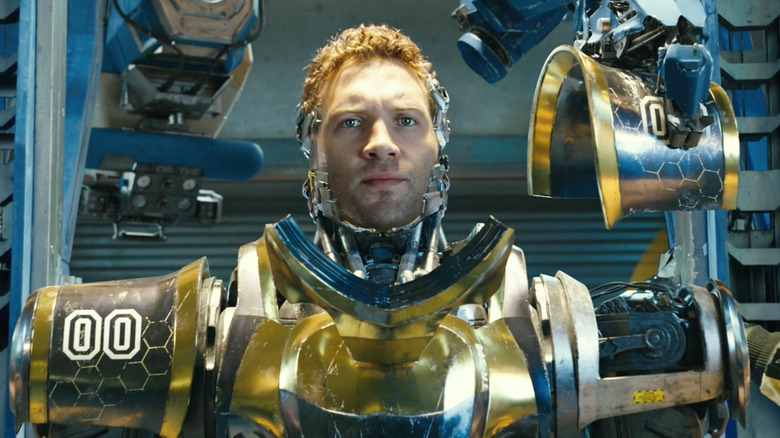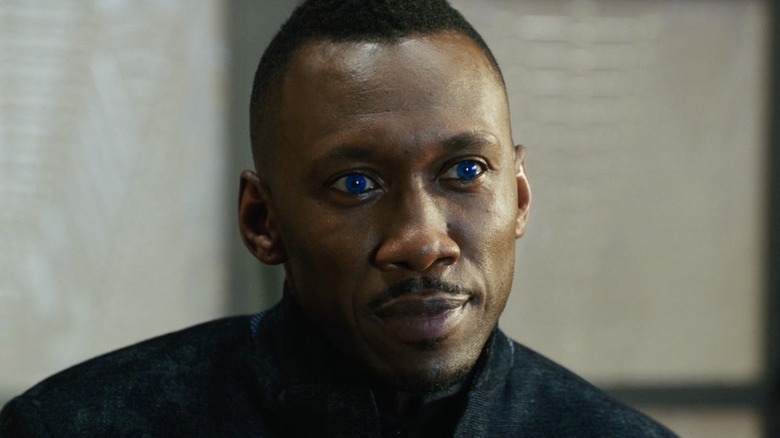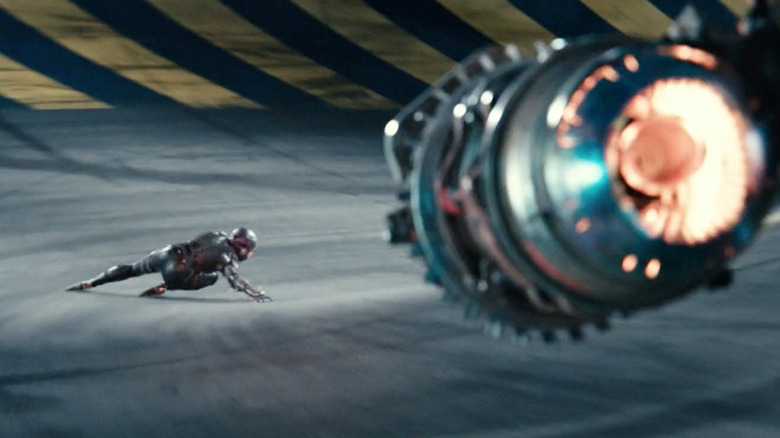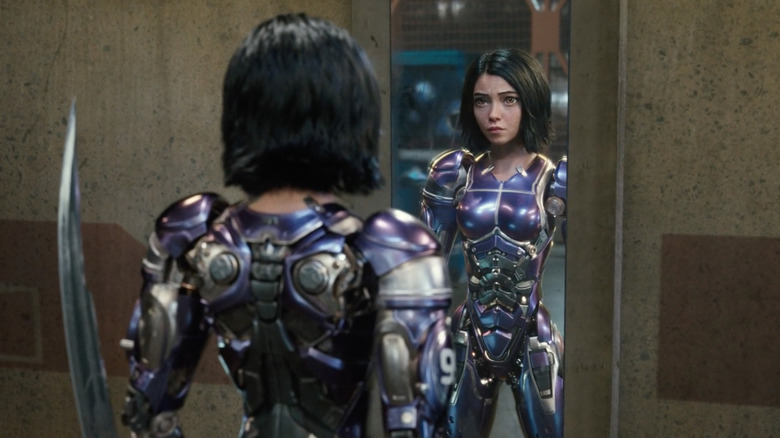Things You Only Notice About Alita: Battle Angel After Watching It More Than Once
2019 saw "Alita: Battle Angel" unleash its gorgeous, cyberpunk adventure upon the world. Director Robert Rodriguez teamed up with producer James Cameron to breathe life into the popular manga of the same name, and audiences were lovestruck. They've been clamoring for a sequel ever since.
Will the "Alita Army" get their wish? No one knows. Rodriguez would love to make an "Alita" sequel, but even he's not sure how likely that is. "Alita: Battle Angel" definitely lays the groundwork for a franchise, what with its expansive world-building and unique characters. Moreover, the movie's high-caliber storytelling attracts new fans every day. More and more people have discovered the heroic cyborg's story as the years have gone on, and they're eager for more.
Watching the film makes it immediately apparent why pressure to deliver more "Alita" continues to mount. A graceful, wide-eyed cyborg slicing through mechanical opponents with an ancient sword engulfed in plasma is everything a tech-junkie could hope for in entertainment. A second viewing brings all sorts of tasty visual treats into view, from "Alita" manga cameos to world-expanding subplots. Indeed, if there isn't an "Alita" sequel in the future, fans are at least lucky enough to have a movie with absolutely enormous rewatch potential. There are a slew of things you only notice about "Alita: Battle Angel" after watching it more than once, and we're here to take a look at them.
There are more CGI-enhanced characters than not
The dystopian 26th century setting of "Alita: Battle Angel" comes complete with a floating sky city, advanced robotics, and even chocolate. Hundreds of years of technological advancement have blurred the line between human and machine. In fact, by the time Alita (Rosa Salazar) steps out onto the bustling streets of Iron City, you've probably ceased to notice the CGI-heavy details of her design. Cybernetic limb replacements are commonplace in this world — in fact, many of the characters are so heavily modified that the only organic component left in them is their brain. As more characters enter the fray, viewers don't even realize on their first watch that there might actually be more CGI-enhanced figures than there are plain old humans.
Excluding the innumerable extras wandering around in the background, few "Alita" characters aren't part machine by the time we reach the finale. Even Alita's main squeeze, Hugo (Keean Johnson), eventually has his dome transferred to a cyborg body. The movie's ability to pull you into this cyberpunk reality is thanks to its top-notch CGI. That's not a surprise, considering the talent behind the camera: James Cameron worked on the film's spectacular visuals for more than a decade. Today's technology allows Rosa Salazar to bring big-eyed Alita to life, and enables every other cyborg character to blend seamlessly into the world depicted, no matter how robotic they are.
The cargo tubes to Zalem are written off as a viable route for no real reason
The central metaphor in "Alita" is blatant: The human elite live in the floating city of Zalem and dump their trash onto Iron City, where the rest of humanity lives. Most of Iron City's population is either desperately trying to scrape by or working feverishly to move to the city above. Alita is repeatedly told that no one ever ascends to life in Zalem — despite people's belief in the possibility, it just doesn't happen.
However, the cargo tubes that ship materials up to Zalem sure seem to be a viable way of sneaking in. The prospect even comes up in conversation, but is dismissed: When Hugo informs Alita about the world around her, he describes the tubes as "meant for cargo, not people." The topic doesn't come up again.
Now, we imagine sneaking into Zalem through a cargo tube would be hazardous. Whatever future gizmo zips cargo around could probably crush a human (or cyborg) body. It might be pressurized in some lethal way. Heck, maybe the journey passes through an alternate dimension that turns human flesh into an Arby's melt. Who knows? But our vast knowledge of heist movies has us thinking there are more possibilities here than Hugo might realize.
Zalem residents have access to immortality
Given the impoverished citizens of Iron City's access to high-tech cybernetics, we can only imagine what type of gadgets exist in Zalem. We never truly see what life is like up there, but we do get a few details that paint a vivid picture. The fact that Dr. Dyson Ido (Christoph Waltz) and Dr. Chiren (Jennifer Connelly) were forced into exile because of their daughter's disease, for example, indicates that death is shunned up there. In fact, Nova's (Edward Norton) words, spoken through his puppets, indicates access to outright immortality.
Just before Alita thrusts her blade through Vector, Nova's voice creeps out to say, "I found the only way to enjoy immortality is to watch others die." On a first watch, the viewer is processing so much information that this detail slips by them. This line immediately follows Grewishka's (Jackie Earle Haley) defeat, after all, and happens mere moments after the reveal of Dr. Chiren's disassembled body. But a rewatch allows its implications to sink in, as do Alita's memories. When they return to her, they reveal that 300 years earlier, she was still battling Nova. Zalem residents seem to have access to technology so advanced, they can achieve immortality while maintaining much of their physical humanity. Meanwhile, Iron City's population is forced to fuse far more clunkily with machines.
Ido's weapon is slow, bulky, and inefficient
Alita's introduction into the world of the hunter-warrior arives thanks to her scrapyard rescuer, Dr. Ido. In order to satisfy the rage he feels over his daughter's death (and also keep his cybernetic surgery practice afloat), the doctor has registered with the Factory as a hunter-warrior. He roams the streets at night, defeating vicious criminals in exchange for bounty payments. His weapon of choice is a rocket hammer, a gigantic blunt weapon with a rocket at one end that propels the device through its target. We only see the doctor fight briefly in one skirmish before Alita steps in and dismantles his opponents with ease. If she hadn't been there, though, we find it difficult to believe Ido would have been successful with his cumbersome weapon.
The criminals in the alley are all cyborgs, boasting blades and mechanical limbs that allow them to leap nimbly from wall to wall. Ido manages to take one of their limbs with his rocket hammer, but after this blow, he stumbles around slowly while trying to wield his massive weapon. Unless Ido has spent years with a 100% success rate on his first fatal blow (a streak that would be ended by this battle), it's hard to believe the man has had a lot of success as a hunter-warrior.
Iron City is located in South America
Where is Iron City located? Originally, it was somewhere "like Kansas City," as director Robert Rodriguez told Empire. Zalem's place in the clouds demanded a more specific location, however. "300 years ago they used to be able to take a space elevator right up [to Zalem]," Rodriguez explained. "It's been torn off during the war, which is why the bottom funnel is ripped." Science-minded James Cameron realized that a space elevator would require the city to be located near the Earth's equator. Thus, Iron City was moved to South America.
This was a wise choice, though few fans probably intuit the science behind it on their own. In fact, most probably don't even realize where Iron City is located the first time around. The setting becomes much more obvious the more you watch "Alita," however: The architecture, signage, and cultural details all point to Latin America. Once you see it, you'll wonder how you didn't realize it before. Probably because you were too busy absorbing everything the future has to offer ... and also because you kept staring into Alita's gigantic, attention-grabbing eyes.
If Nova wants Alita dead, why didn't he do it himself?
Multiple viewings of "Alita" have only left us more confused as to what the heck Nova is up to. We understand that centuries of life have cursed him with a boredom that can only be cured by toying with the mortality of others, but the actions he takes involving Alita are just plain contradictory. When it is revealed that Alita is over 300 years old, we realize that her brain and heart were up in Zalem for all that time, before being dumped into Iron City's scrapyard. Considering Nova is always experimenting with human body parts, we're puzzled as to why he would throw the most powerful heart in existence out with the trash. Nova callously discarding Alita's brain makes some amount of sense, but why would he throw out a power source like her heart?
Even accounting for the fact that some of the movie's subplots might have been left ambiguous for the purposes of a sequel, we're still confused by Nova's approach. His first instinct after learning Alita is still alive is to order her death ... a task he would have been perfectly capable of executing on his own over the past 300 years. Then again, maybe he's bored with power. The sly, smirking mad scientist might just embrace the chaos of it all.
Alita's arc plasma powers the Damascus Blade
It's just like a teenager to go out and pulverize their machine body in order to force their cybernetic father to reunite them with the most powerful cyborg body ever created. Right? Well, that's how it goes in "Alita," anyway. Alita finds the body, which possesses lost technology from the URM (United Republic of Mars), in the ancient wreckage outside the city. Ido refuses to attach Alita to the old body, but after Grewishka slices her apart, he gives in. Thus, Alita is fused with the Berserker, a body of immense power and skill.
When Alita awakens in her new form, she shows off by executing a graceful handstand on her index finger. After righting herself, she notices an intake flow on her shoulder that generates arc plasma at her finger. It seems like a pointless (if very cool) detail on a first watch, one you might assume is a nod to the original manga. But after seeing how everything plays out again, you'll realize this device's purpose. After Alita relieves Zapan of the ancient Damascus Blade, she displays the ability to engulf the weapon in a glowing blue plasma. It is that little blue flame created by Alita's index finger that pumps power into the sword and allows her to slice through sentinels like butter.
Motorball seems to be more about violence than scoring
Three centuries after the Fall, motorball dominates the public. Every kid grows up playing the sport, albeit with a little less death involved. Alita is introduced to the game by Hugo and plays with the neighborhood kids while learning how it all works. At its core, motorball comes down to ball possession and scoring. After watching the movie a few times, however, we're starting to think scoring takes a backseat to being the last one standing in professional motorball.
When we see a professional motorball match in action, some players do appear to chase the elusive ball. But many other players seem to ignore it, interested only in ripping through their opponents with whatever new-age weaponry the league has deemed legal. If we're being honest, we wouldn't have it any other way: Motorball sans carnage would just be robots on rollerblades. The grand arena is a place for these futuristic gladiators to flex their might and satiate the public's lust for violence. If they happen to toss that wonky ball into the goal while shredding their machine bodies and punting a few human heads out of the rink, well, that makes for extra bragging rights.
Jashugan's actor is key to a sequel
The biggest detail in "Alita: Battle Angel" pointing to a sequel is Nova's reveal at the end of the film. However, there are numerous other details hidden throughout the movie, hinting towards additional plots ripe for expansion. One of the biggest occurs when Alita is being shown around the motorball track by Hugo. When she asks who the best player in the game is, Hugo responds by saying Jashugan is on track to be champion. For less than 10 seconds, attention turns to the motorball player in question as he receives repairs. It happens so quickly, you might not notice that Jashugan is played by Jai Courtney, star of "Suicide Squad," "Divergent," and "Terminator: Genisys."
An actor known for his work in other blockbuster franchises hints to more being in store for this character. Indeed, in the manga, there are interesting connections between Nova and Jashugan which leave plenty of room for story development. Courtney confirmed this thought process in an interview with Business Insider, saying, "[Rodriguez] called me up when they were in production and said, 'There's this role, it's a little small on paper but if this thing blows up I'll need someone who I can rely on when we revisit it.'" That definitely tells us Rodriguez has much more locked and loaded, should an "Alita" sequel get the green light.
Vector fulfills all his promises
The seedy underbelly of Iron City is run by a man named Vector (Mahershala Ali). His power stems from his corruption of professional motorball. Vector holds sway over the game's odds by tweaking the players' power, going so far as to hire naïve youth to abduct and rob cyborgs of their limbs. His direct connection to Zalem enables such manipulation: He uses this relationship to make those around him believe he has the power to send people to the floating city. Vector dangles this promise in front of his lackeys — until they wise up and decide they've had enough. It is at this moment that he fulfills his end of the bargain and sends them to Zalem ... albeit not in the way they'd hoped.
Confused? If you've only watched "Alita" once, you might not have cottoned on to this detail. When Dr. Chiren decides to quit her position with Vector, he tells her, "I could send you up there right now." The next time we see her is after Alita crashes into Vector's office. He opens up a chest, revealing Chiren's dismantled body being kept alive, ready to make its journey to Zalem. Dr. Chiren's fate is not exclusive to her: Those he promises to send to Zalem really do get there, just in pieces. He's basically an evil genie with whom you should be more specific.
Guns are outlawed in Iron City ... except in motorball
There are a couple rules regarding what weapons are allowed in the motorball arena, but they're pretty lax. In fact, after watching the movie a few times, you can't help but notice how the sport transcends the laws of Iron City at large. Guns are outlawed here — Hugo dictates as much when informing Alita about the law, while referencing the sword being carried by Zapan. The need for unique weapons among the hunter-warriors makes sense, given this stipulation. So, uh, what's with the arm cannon in motorball?
When Alita is being chased down by an entire team of bloodthirsty motorball competitors hell-bent on placing her head on a pike, one of them fires a cannon at her, causing a projectile explosion that knocks Alita off her feet. Now, we immediately picture bullet-firing pistols in regards to the "no guns" policy, but rocket launchers really seem like they should fall into that illegal category as well. The announcer can be heard mentioning legality and regulations during the matches, but we're thinking that might just be for show. Seriously, the cannon forms one player's entire, gigantic arm. That really seems like it should count.
After Hugo's death, Alita's body changes once again
"A warrior's spirit needs a warrior's body," Dr. Ido declares when Alita shows off her new Berserker body. The synergy Alita has with her new (well, sort of) body is indeed remarkable. The body boasts miraculous nanotechnology: Once Alita is attached to the Berserker, the entire system synchronizes with her mind and begins making macro-adjustments to better represent her sense of self. This characteristic is subtly put on display again during the closing moments of the film.
Compared to how her Berserker form appears when she's first attached to it, the body we're shown later is much more attuned to combat. This hints to what Alita has been through in the months after Hugo's death. Chiefly, she's fought her way through the motorball league — no easy task. Thus, her body has changed to reflect her circumstances. It's a literal adaptation, but also a reflection of Alita's inner nature, and her boundless potential. You can't help but wonder what other forms she might be able to take — perhaps in a sequel, if fans get their wish.
